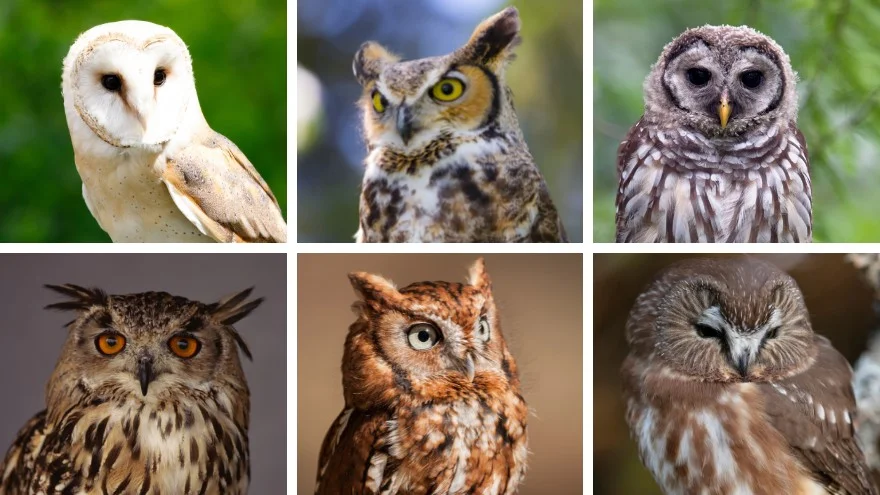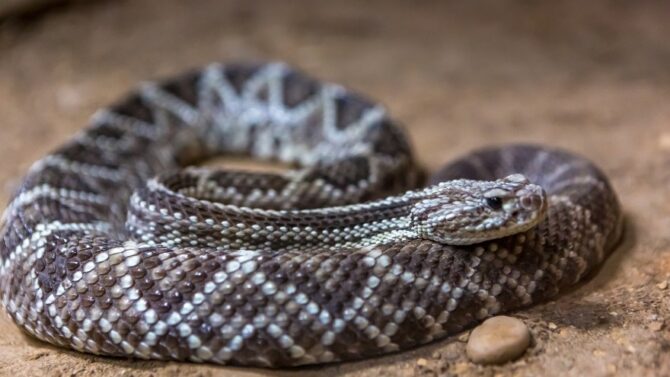Missouri, a state in the United States’ Midwestern region, is well-known for its museums, botanical gardens, and barbecues.
The region’s numerous state parks are great for picnics, camping, and hiking.
This “Show-me state” is home to over 430 species of birds thanks to its diverse terrain and advantageous location. It’s not just about tall buildings and historical sites.
Eight owls in Missouri are included in this group, including the popular great horned owl, the secretive eastern screech owl, and the uncommon snowy owl.
All eight species have been listed in this article, along with details about each one’s unique traits and when and where to look for them.
Discover the Species of Owls in Missouri
Owls are incredibly distinctive raptors. They typically hunt at night and can fly stealthily all thanks to their distinctive feathers.
The eight species of owls that live in Missouri listed below have a lot in common but also differ significantly from one another.
1. Great Horned Owl
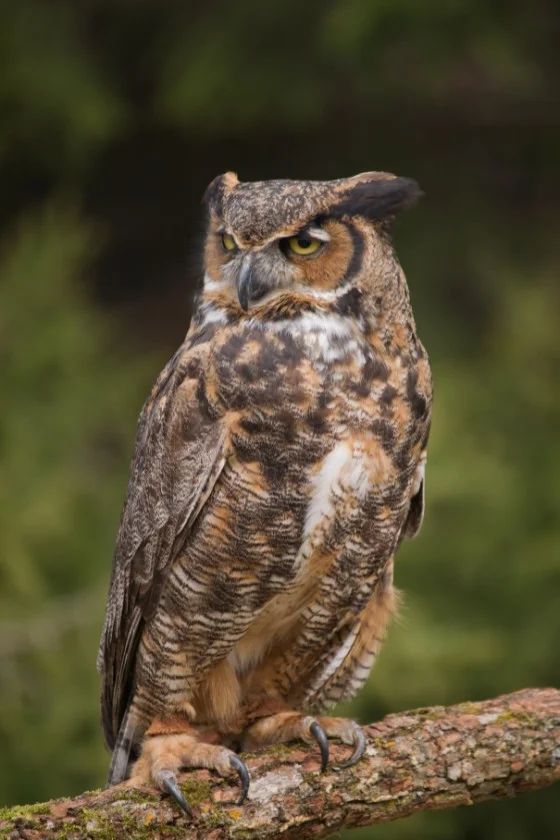
- Scientific Name: Bubo virginianus
- Length: 18.1 – 24.8 inches (46 – 63 cm)
- Weight: 910 – 2500 g (2.0 – 5.5 lbs)
- Wingspan: 39.8 – 57.1 inches (101 – 145 cm)
The Great horned owl is one of the largest and most popular owls in the world, not only in North America.
These owls have two noticeable feathered tufts on their heads that resemble horns, giving them their name.
They are large and thick-bodied birds. They have a reddish brown facial disk, big yellow eyes, and a distinctive white patch on their throats.
These birds are mottled gray-brown colored. They can fly silently thanks to their delicate, fluffy feathers, which keep them warm in the winter and provide a significant advantage when ambushing small rodents and other prey.
Great horned owls spend the entire year in Missouri. They prefer deciduous woods and secondary-growth woodlands, but they can also be found in urban and suburban settings, including parks and cities.
“Hoo HooHoooooo HooHoo” is the sound of a great horned owl calling. On a quiet night, the sounds can be heard from a great distance.
2. Eastern Screech Owl

- Scientific Name: Megascops asio
- Length: 6.3 – 9.8 inches (16 – 25 cm)
- Weight: 121 – 244 g (0.27 – 0.54 lbs)
- Wingspan: 18.9 – 24.0 inches (48 – 61 cm)
Eastern screech owls are year-round residents of Missouri, but it’s rare to witness one.
They blend seamlessly with the woods and bushes because of their outstanding camouflage.
In most types of woods and forests, they take up residence in empty tree cavities, frequently close to water sources.
Listening to their nighttime trills, which somewhat resemble a horse’s whinny, is a good way to find them.
Eastern screech owls are small, like northern saw-whet owls. They can easily fit in the palm of your hand and are not much larger than adult-sized mockingbirds.
They have no necks, stocky bodies, conspicuous, occasionally depressed ear tufts, yellow eyes, and no ears. Brown, gray, and red are the three color morphs that they take on.
The brown morph is the most prevalent in the state, and the red morph is the least prevalent.
Despite their name, eastern screech-owls’ sounds are rarely referred to be “screeches.”
Instead, they make a monotonous trill typically sung with their mate or a quavering whistled sound with an increasing pitch.
3. Barn Owl
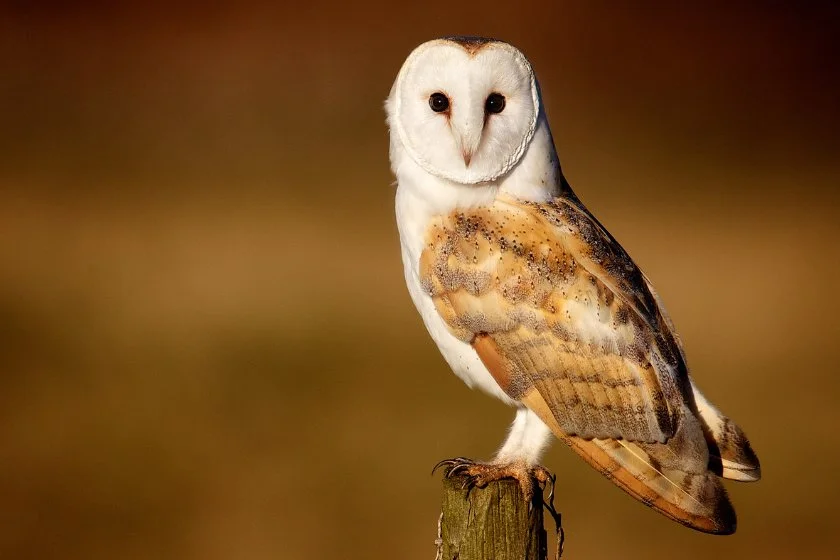
- Scientific Name: Tyto alba
- Length: 12.6 – 15.8 inches (32 – 40 cm)
- Weight: 400 – 700 g (0.9 – 1.5 lbs)
- Wingspan: 99.1 – 114.3 cm ( 39 – 45 inches)
Some of the most unusual owls in the world are Barn owls. They’re either lovely or scary, depending on who you ask.
With their dark, outward-looking eyes, cryptically colored plumage, and pale, heart-shaped faces, they have a somewhat “ghostly” appearance.
Their bodies are light tan with gray markings on their heads, necks, and upper wings. They have pale white faces with dark eyes.
In Missouri, you can see barn owls all year long. They inhabit chimneys, steeples of churches, and other man-made buildings. Barn owls are the rarest of the owl species residing in Missouri annually.
Barn owls appear as a flash of white when night falls. They exclusively hunt at night because they are truly nocturnal.
They are skilled at using sound to find their prey, even if it is hidden by snow or vegetation.
Since they are expert rodent hunters, farmers and homeowners frequently erect nest boxes to entice them to hunt on their land.
They don’t hoot as other owls do; instead, they make ominous, screeching noises.
4. Barred Owl
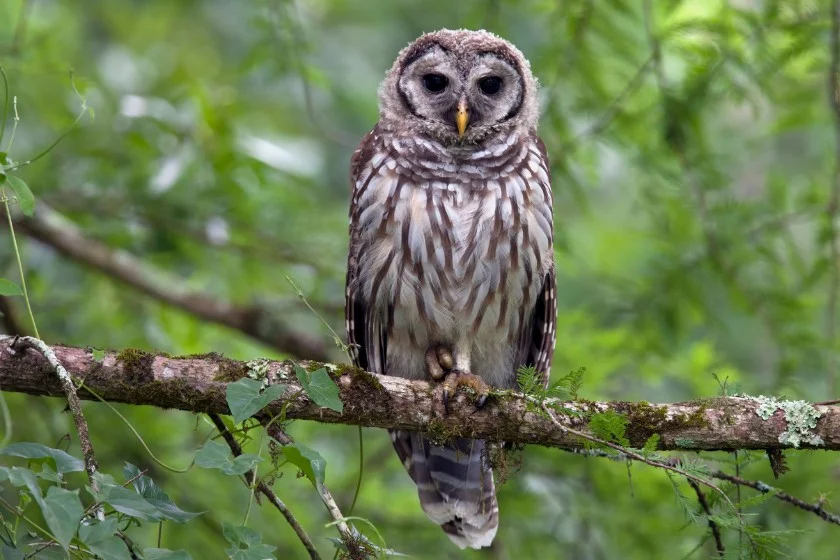
- Scientific Name: Strix varia
- Length: 16.9 – 20.1 inches (43 – 51 cm)
- Weight: 470 – 1050 g (1.0 – 2.3 lbs)
- Wingspan: 96 – 125 cm (37.8 – 49.2 inches)
The barred owl is a large, stout owl with a brown and white spotted body and dark eyes. They have rounded tails and heads without ear tufts.
They blend in perfectly with the trees they roost in throughout the day, thanks to their light brown coloring.
With barn owls being the only dark-eyed species of their kind, these are the only brown-streaked, dark-eyed owls in Missouri.
These nocturnal birds get their name from their barred plumage, which has horizontal bands of light and dark brown that alternate.
They frequently reside close to water bodies in sizable, mature woods of deciduous and evergreen trees. They build their nests in tree cavities.
Barred owls are nocturnal hunters. Most people recognize them from their unique call that sounds like they’re saying, “Who cooks for you? Who cooks for you all?”
Their voice is difficult to identify because it is ventriloquial. In addition to confusing potential prey, this tactic safeguards barred owls from predators.
5. Northern Saw-Whet Owl
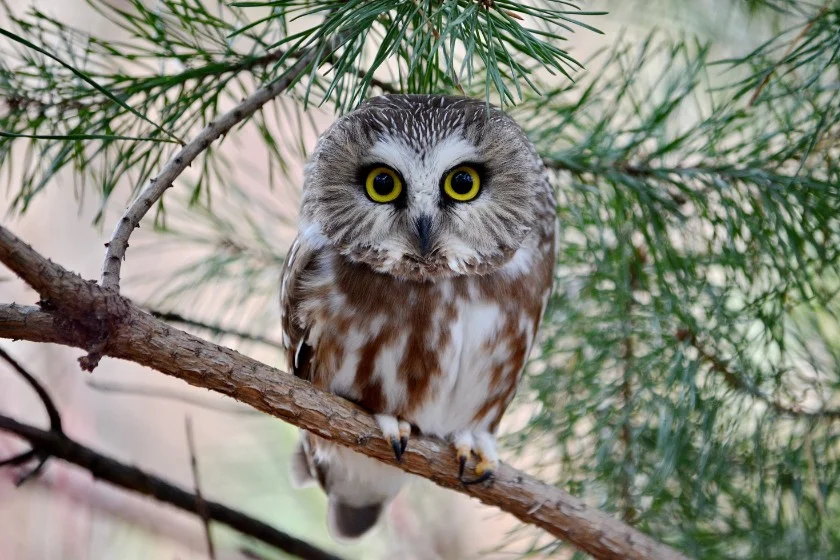
- Scientific Name: Aegolius acadicus
- Length: 7.1 – 8.3 inches (18 – 21 cm)
- Weight: 65 – 151 g (0.14 – 0.33 lbs)
- Wingspan: 16.5 – 18.9 inches (42 – 48 cm)
The smallest owls in Missouri and most of Northern America are the Northern saw-whet owls. These owls are not only tiny, but they are also hard to spot.1
Their heads seem to be a third of the size of their bodies, which is too big for them. They have large, bright eyes, a brown forehead with white streaks, and mottled brown feathers.
Because of their natural coloration, they can blend in with plants and trees.
Northern saw-whet owls conceal themselves throughout the day in dense evergreens, amongst vines, or in tree cavities that once belonged to pileated woodpeckers.
In Missouri, there are only non-breeding populations of these owls. They are even harder to find throughout a sizable chunk of the state.
The sound a saw makes when it is sharpened on a whetting stone is supposed to be the source of the name of this saw-whet.
From January to May, on calm evenings, you could hear their brief, high-pitched toot-toot-toot call.
6. Long-Eared Owl

- Scientific Name: Asio otus
- Length: 13.8 – 15.8 inches (35 – 40 cm)
- Weight: 220 – 435 g (0.5 – 0.96 lbs)
- Wingspan: 35.4 – 39.4 inches (90 – 100 cm)
Long-eared owls are relatively dark birds with buff or orange faces. Their feathers are intricately patterned with black, brown, and buff colors.
They are slim owls with long ear tufts that often point straight up like exclamation points, giving them the appearance of being surprised rather frequently.
Long-eared owls can catch prey in total darkness thanks to their keen hearing and nimble flying abilities.
These nocturnal hunters hunt for small mammals over grasslands while camping out in deep vegetation where camouflage makes them difficult to spot.
In addition to open woods and shrub regions, long-eared owls live in dense vegetation adjacent to grasslands. All around Missouri, they can be found in woods and woodlands.
Long-eared owls are the most musical owls, so named because of their long ear tufts. They can make more than 200 different noises, such as hoots, whistles, screeches, meows that sound like cats, and even barks.
7. Short-Eared Owl
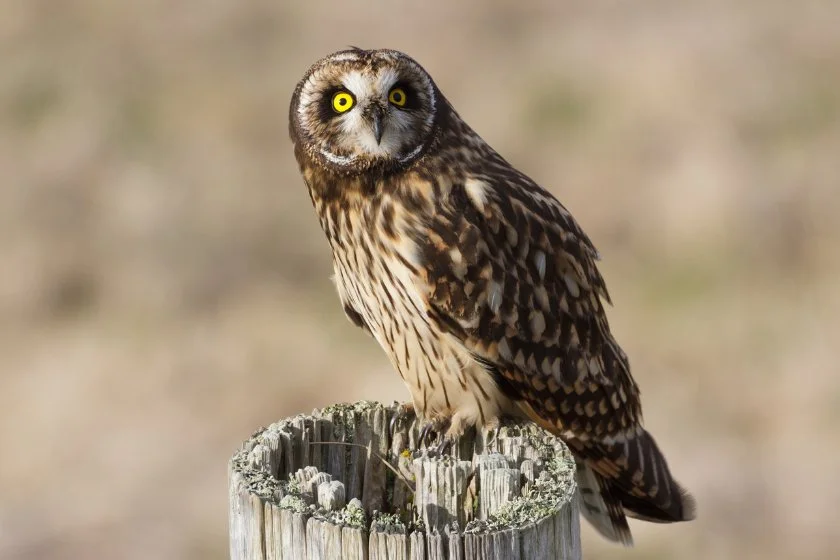
- Scientific Name: Asio flammeus
- Length: 13.4 – 16.9 inches (34 – 43 cm)
- Weight: 206 – 475 g (0.45 – 1.05 lbs)
- Wingspan: 33.5 – 40.5 inches (85 – 103 cm)
Short-eared owls have red, brown, and white feathers that resemble flames, hence the scientific name flammeus.
They have yellow eyes with a black rim and pale, disc-shaped faces. The outside of their wings has a buff patch.
Short-eared owls, like long-eared owls, get their name from their almost nonexistent ear tufts. Except when startled or when they seek to intimidate a species, their ear tufts are typically flat on their heads.
Short-eared owls are found in Missouri’s Glaciated Plains, Mississippi Lowlands, and Osage Plains.
Unlike most owl species, short-eared owls are diurnal, which means they hunt during the daytime rather than at night. They may be roosting in a grassy, dry stream.
When they fly, they flap with even, stiff beats that give the impression of grace and ease. Thanks to their large, rounded wings, they can glide silently across open spaces and fields.
Short-eared owls are not exactly vocal but can bark, scream, and whine when defending their nest.
8. Snowy Owl
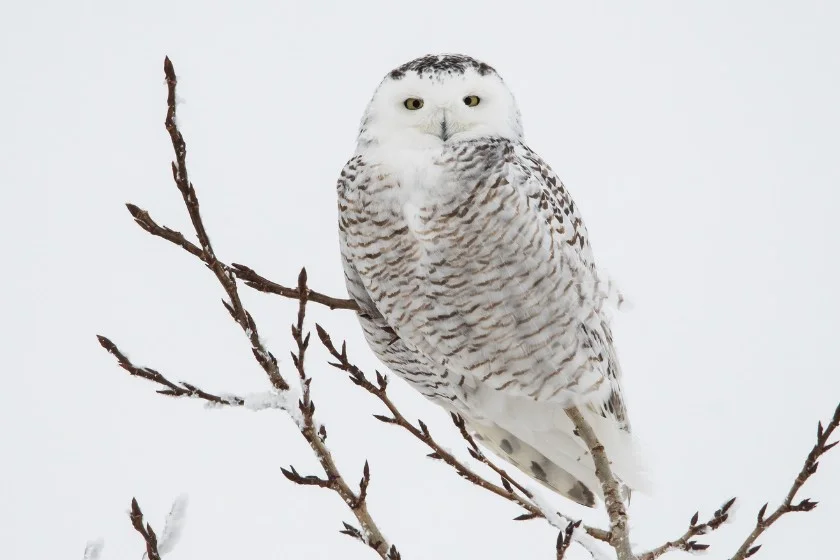
- Scientific Name: Bubo scandiacus
- Length: 20.5 – 27.9 inches (52 – 71 cm)
- Weight: 1600 – 2950 g (3.5 – 6.5 lbs)
- Wingspan: 49.6 – 57.1 in (126 – 145 cm)
Snowy owls have bulky, heavily feathered bodies and smooth, rounded heads. They are very large owls, bigger than even great horned owls.
They also have spherical heads without tufts and large golden eyes. The most evident distinction between these and other owls is their stunning white plumage.
Open tundra, coastal dunes and prairies, open moorland, meadows, marshes, and agricultural areas are all home to these magnificent birds.
Hummocks, knolls, ridges, bluffs, and rocky outcrops are among the terrain features they favor that have some rising elevation.
These owls are one of the few diurnal owl species. Even though they prefer to hunt at night, they occasionally use daytime to their advantage.
They are quiet and reserved birds. The alarm sound of these birds is a barking, almost quacking krek-krek, while the female also has a gentler meowing pyee-pyee or prek-prek call.
Other Related Questions
What is the most common owl in Missouri?
In Missouri, great horned owls are prevalent. In fact, from the Arctic south to the tropics, these raptors can be found practically wherever in North America. What is the rarest owl in Missouri?
What is the rarest owl in Missouri?
In Missouri, long-eared owls are uncommon and typically only visible from mid-November to mid-April. They roost collectively in dense pine groves and are solitary during the day.
Are owls friendly to humans?
In general, owls are not naturally friendly to people and are not tolerated by them, especially when they try to touch, pet, or handle them in any way. Even captive birds exhibit discomfort around people and hand-raised owlets may also avoid having too much contact with humans.
Wrap-up
We hope you enjoyed reading our article on the eight owl species that are most prevalent in Missouri.
Eight different owl species may be found in Missouri. They are also overly helpful in reducing insect and rodent populations.
Next up…
- 9 Owls In Oklahoma (Species Identification, Facts, Pictures)
- 30 Beautiful Birds With Mohawks (With Pictures & Facts)
- 10 Most Dangerous Animals In Missouri That Are Deadly
References & Notes
Facts Sources:
- Northern Saw-Whet Owl. Missouri Department of Conservation.
